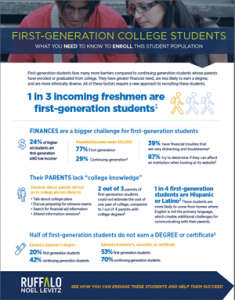enrollment
Integrating Latino college students into your institutional framework: Thoughts from the National Hispanic Institute
This post is a conversation with Nicole Nieto about Latino college students. She is the executive vice president of the National Hispanic Institute and the daughter of its founder and president, Ernesto Nieto. She has been with the organization for 20 years.
The National Hispanic Institute (NHI) was established in 1979 to provide the Latino community with a means to identify, select, and train its future leaders. Through community organization endeavors and the design of powerful leadership programs for high school age youth, NHI has heightened the community leadership capacities of 100,000 students from throughout the United States and parts of Latin America. The three core summer programs broaden young people’s communication skills, governance and organizational development capacities, self-management abilities, social networks, knowledge of challenges that face Latino communities, and college opportunities. The impact of the NHI leadership experiences on students trend toward increased personal initiative, self-determination, innovative thinking, and community collaboration towards common endeavors.
The NHI is often asked if there is a “secret recipe” that inspires youth to engage in their own personal and professional development. Our tips fall in two areas:
1) the organizational culture of the institution
2) programs/activities that can support student success.
We believe that the organizational culture of colleges and universities plays a significant role in how Latino college students integrate into campus life. As freshmen arrive to campus for the first time, they may immediately feel familiar with campus culture or “foreign” to it. While most students sense the excitement of a new place and space, some may feel a greater need to give up part of themselves to fit in; others feel at home and may even be trend-setters. Students who feel the need for great “self-change” may struggle to fit into their environment, making life more stressful than usual.
An institution that strives to create an atmosphere where each student feels valued and respected may ask itself: Is there a set of challenging experiences where all students are required to undergo self-change, whereby no student from any particular background has a clear and strong advantage over others?
The NHI, for instance, has designed leadership challenges where academic readiness has little value in success. Instead, initiative, determination, collaboration, courage, and inspiring others earn greater rewards. When students feel valued in these areas, even if they are not as academically prepared, they are able to lead in the formation of new organizations, networks, and social circles. This builds a strong sense of belonging and value in the group, which positively impacts retention and encourages them to remain visible leaders.
The next point has to do with whether the university only perceives Latino college students from a consumer/market view, or whether the institution is willing to undergo a cultural revision in its institutional make-up. By inviting Latino college students to enroll in the campus community, does the institution see itself as assisting them in a successful “community exit strategy,” or does the institution view itself as a platform through which students can develop themselves to subsequently advance their families and home communities?
If the former, then the assumption is that students need to be culturally transformed to better fit into a new life role and culture. If the latter, then the institution may elect to study what the possible leadership and educational talent needs are of the communities from which these students come. Again, is the idea for students to join a new culture or to prepare themselves to better manage their role in the families and communities from which they hail? Only the institutional leadership can answer this and give policy direction around it.
Many individuals tasked with outreach and recruitment of Latino college students are tasked with figuring out how to excite students about campus opportunities and compel them to apply and possibly enroll. The work of creating sustainable traditions in Latino communities has taken NHI more than 30 years to develop, so we cannot say there are quick and easy answers. However, what we can recommend are the following tips:
- Outreach and retention: Familiarize the parents of Latino college students with your campus, inform them about its safety, and introduce them to campus faculty or student life personnel who they can call in an emergency. This will help strengthen trust among parents.
- Outreach: Develop materials in Spanish that are available on your website, and make sure you have admission personnel who speak Spanish to build connections with families.
- Outreach: Build value and capacity in your current Latino college students. Ask current students to serve on advisory boards and in committees for outreach/recruitment efforts. Train them to host meet-and-greet meetings and make public relations calls to students in their home towns. The idea is to build a tradition in concentrated Latino schools and areas.
- Retention: Involve new students immediately in volunteer endeavors at the institution by asking them to serve in roles such as tour guides, parent hosts, admissions hosts, etc. Give them a title (aka Student Ambassador, etc.) and publicly thank them for their contribution.
- Retention: Encourage Latino campus organizations to incorporate mentorship programs into their year-round work programs whereby incoming students feel welcome and connected immediately to established students.
- Retention: Invite incoming freshmen to get involved in a “success club” whereby they agree to team up with academic counselors if grades fall below a certain mark. Upper classmen can help mentor students on time management, best study practices, rest, exercise, and nutrition to encourage a healthy lifestyle and also being in the best possible physical and mental state for achievement.
- Associations: Utilize community-based organizations, like the National Hispanic Institute, to invite students and parents to local meetings during your outreach visitations and to access databases of eligible candidates.
The NHI offers many opportunities for Latino college students, such as our progressive leadership academy of programs during the summer and programs for high school sophomores, juniors, and seniors to develop their skills. Visit the website for all of the latest information.
What about recruiting Latino college students? Talk with RNL

Nearly all colleges and universities want to increase the diversity of their college classes, and Latino college students are expected to increase significantly in the next decade. But these students have unique expectations, goals, concerns, and challenges. For instance, many are first-generation college students who have significant barriers to afford and attend college. What do you need to do to really engage Latino college students and assure them your institution is a good fit?
The enrollment experts at RNL can help. They have worked with public and private institutions to shape their enrollments and increase the diversity of their classes. See our solutions for enrollment management, or ask for a consultation and we will set up a time to talk.
